NVIDIA GeForce GTX 780 Review: The New High End
by Ryan Smith on May 23, 2013 9:00 AM ESTCompute
Jumping into compute, we should see a mix of results here, with some tests favoring the GK110 based GTX 780’s more compute capable design, while other tests will punish it for not being a fast FP64 card like GTX Titan.
As always we'll start with our DirectCompute game example, Civilization V, which uses DirectCompute to decompress textures on the fly. Civ V includes a sub-benchmark that exclusively tests the speed of their texture decompression algorithm by repeatedly decompressing the textures required for one of the game’s leader scenes. While DirectCompute is used in many games, this is one of the only games with a benchmark that can isolate the use of DirectCompute and its resulting performance.
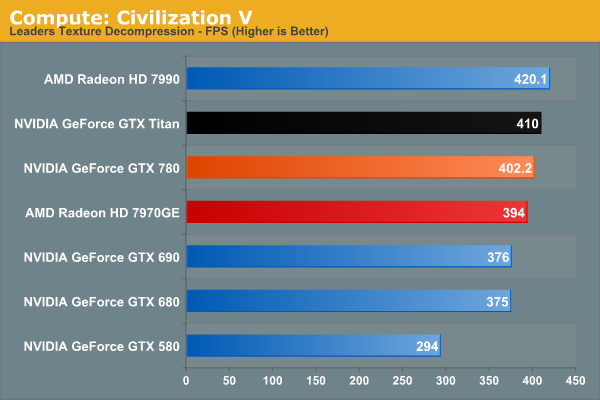
Civilization V’s DirectCompute performance is looking increasingly maxed out at the high end. At 402fps the GTX 780 may as well be tied with GTX Titan. On the other hand it’s a reminder that while we don’t always see NVIDIA do well in our more pure compute tests, it can deliver where it matters for games with DirectCompute.
Our next benchmark is LuxMark2.0, the official benchmark of SmallLuxGPU 2.0. SmallLuxGPU is an OpenCL accelerated ray tracer that is part of the larger LuxRender suite. Ray tracing has become a stronghold for GPUs in recent years as ray tracing maps well to GPU pipelines, allowing artists to render scenes much more quickly than with CPUs alone.
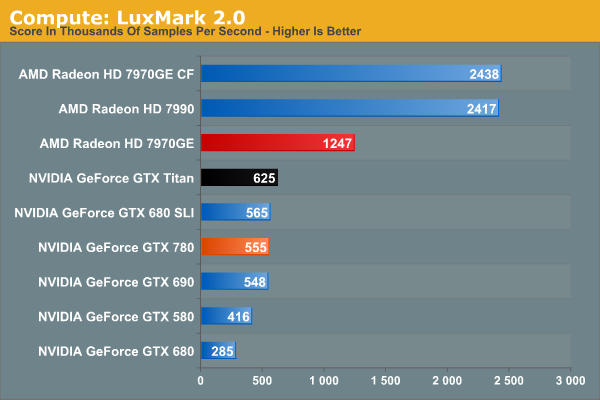
NVIDIA has never done well at LuxMark, and GTX 780 won’t change that. It’s greatly faster than GTX 680 and that’s about it. Kepler parts, including GK110, continue to have trouble with our OpenCL benchmarks, as evidenced by the fact that GTX 780 doesn’t beat GTX 580 by nearly as much as the generational improvements should lead to. GK110 is a strong compute GPU, but not in ways that LuxMark is going to benefit.
Our 3rd benchmark set comes from CLBenchmark 1.1. CLBenchmark contains a number of subtests; we’re focusing on the most practical of them, the computer vision test and the fluid simulation test. The former being a useful proxy for computer imaging tasks where systems are required to parse images and identify features (e.g. humans), while fluid simulations are common in professional graphics work and games alike.
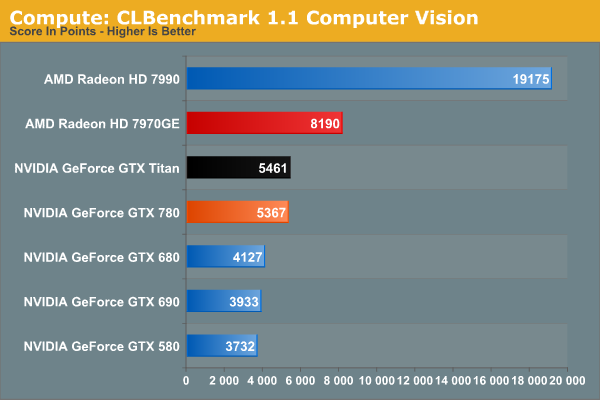
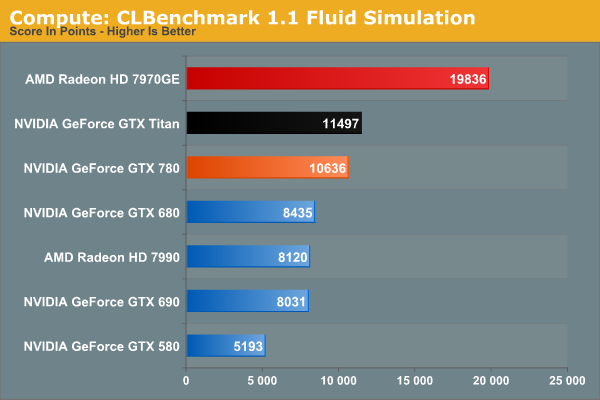
GTX 780 still struggles some at compute with CLBenchmark, but less so than with LuxMark. 7970GE is the clear winner here in both tests, while GTX 780 stays remarkably close to GTX Titan in performance. The fluid simulation in particular makes GTX 780 look good on a generational basis, more than doubling GTX 580’s performance.
Moving on, our 4th compute benchmark is FAHBench, the official Folding @ Home benchmark. Folding @ Home is the popular Stanford-backed research and distributed computing initiative that has work distributed to millions of volunteer computers over the internet, each of which is responsible for a tiny slice of a protein folding simulation. FAHBench can test both single precision and double precision floating point performance, with single precision being the most useful metric for most consumer cards due to their low double precision performance. Each precision has two modes, explicit and implicit, the difference being whether water atoms are included in the simulation, which adds quite a bit of work and overhead. This is another OpenCL test, as Folding @ Home has moved exclusively to OpenCL this year with FAHCore 17.

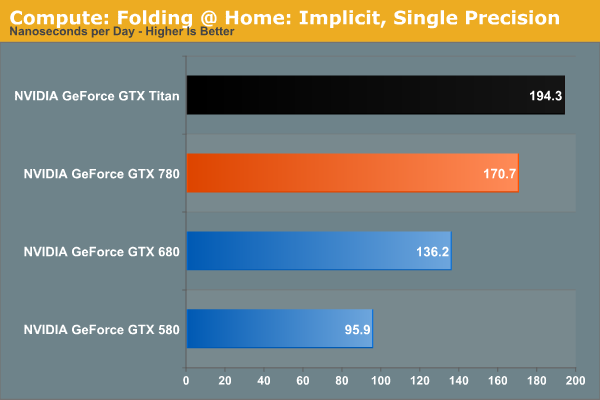
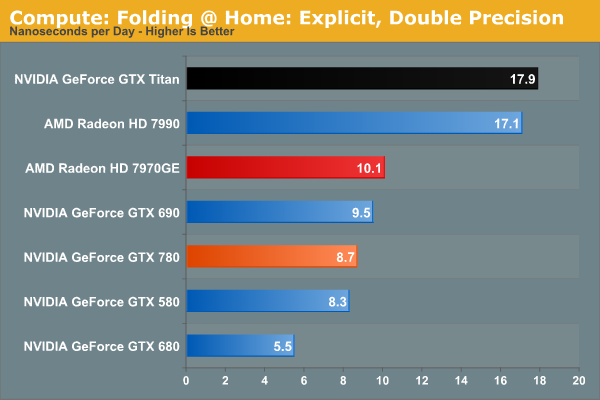
The Folding@Home group recently pushed out a major core update(FAHBench 1.2.0), which we’ve rerun on a number of cards and is reflected in our results. Unfortunately this version also broke single precision implicit on AMD GPUs and AMD’s latest drivers, so we only have NVIDIA GPUs for that section.
In any case, despite the fact that this is an OpenCL benchmark this is one of the cases where NVIDIA GPUs do well enough for themselves in single precision mode, with GTX 780 surpassing 7970GE, and falling behind only GTX Titan and the 7990. GTX 780 doesn’t necessarily benefit from GK110’s extra compute functionality, but it does see a performance improvement over GTX 680 that’s close to the theoretical difference in shader performance. Meanwhile in double precision mode, the lack of an uncapped double precision mode for GTX 780 means that it brings up the bottom of the charts compared to Titan and its 1/3 FP64 rate. Compute customers looking for a bargain NVIDIA card (relatively speaking) will need to stick with Titan.
Wrapping things up, our final compute benchmark is an in-house project developed by our very own Dr. Ian Cutress. SystemCompute is our first C++ AMP benchmark, utilizing Microsoft’s simple C++ extensions to allow the easy use of GPU computing in C++ programs. SystemCompute in turn is a collection of benchmarks for several different fundamental compute algorithms, as described in this previous article, with the final score represented in points. DirectCompute is the compute backend for C++ AMP on Windows, so this forms our other DirectCompute test.
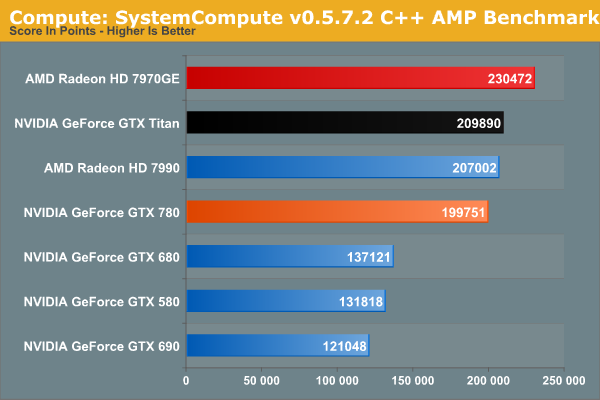
SystemCompute shows very clear gains over both the GTX 680 and GTX 580, while trailing the GTX Titan as expected. However like Titan, both trail the 7970GE.










155 Comments
View All Comments
lukarak - Friday, May 24, 2013 - link
1/3rd FP32 and 1/24th FP32 is nowhere near 10-15% apart. Gaming is not everything.chizow - Friday, May 24, 2013 - link
Yes fine cut gaming performance on 780 and Titan down to 1/24th and see how many of these you sell at $650 and $1000.Hrel - Friday, May 24, 2013 - link
THANK YOU!!!! WHY this kind of thing isn't IN the review is beyond me. As much good work as Nvidia is doing they're pricing schemes, naming schemes and general abuse of customers has turned me off of them forever. Which convenient because AMD is really getting their shit together quickly.chizow - Saturday, May 25, 2013 - link
Ryan has danced around this topic in the past, he's a pretty straight shooter overall but it goes without saying why he isn't harping on this in his review. He has to protect his (and AT's) relationship with Nvidia to keep the gravy train flowing. They have gotten in trouble with Nvidia in the past (sometime around the "not covering PhysX enough" fiasco, along with HardOCP) and as a result, their review allocation suffered.In the end, while it may be the truth, no one with a vested interest in these products and their future success contributing to their livelihoods wants to hear about it, I guess. It's just us, the consumers that suffer for it, so I do feel it's important to voice my opinion on the matter.
Ryan Smith - Sunday, May 26, 2013 - link
While you are welcome to your opinion and I doubt I'll be able to change it, I would note that I take a dim view towards such unfounded nonsense.We have a very clear stance with NVIDIA: we write what we believe. If we like a product we praise it, if we don't like a product we'll say so, and if we see an issue we'll bring it up. We are the press and our role is clear; we are not any company's friend or foe, but a 3rd party who stakes our name and reputation (and livelihood!) on providing unbiased and fair analysis of technologies and products. NVIDIA certainly doesn't get a say in any of this, and the only thing our relationship is built upon is their trusting our methods and conclusions. We certainly don't require NVIDIA's blessing to do what we do, and publishing the truth has and always will come first, vendor relationships be damned. So if I do or do not mention something in an article, it's not about "protecting the gravy train", but about what I, the reviewer, find important and worth mentioning.
On a side note, I would note that in the 4 years I have had this post, we have never had an issue with review allocation (and I've said some pretty harsh things about NVIDIA products at times). So I'm not sure where you're hearing otherwise.
chizow - Monday, May 27, 2013 - link
Hi Ryan I respect your take on it and as I've said already, you generally comment on and understand more about the impact of pricing and economy more than most other reviews, which is a big part of the reason I appreciate AT reviews over others.That being said, much of this type of commentary about pricing/economics can be viewed as editorializing, so while I'm not in any way saying companies influence your actual review results and conclusions, the choice NOT to speak about topics that may be considered out of bounds for a review does not fall under the scope of your reputation or independence as a reviewer.
If we're being honest here, we're all human and business is conducted between humans with varying degrees of interpersonal relationships. While you may consider yourself truthful and forthcoming always, the tendency to bite your tongue when friendships are at stake is only natural and human. Certainly, a "How's your family?" greeting is much warmer than a "Hey what's with all that crap you wrote about our GTX Titan pricing?" when you meet up at the latest trade show or press event. Similarly, it should be no surprise when Anand refers to various moves/hires at these companies as good/close friends, that he is going to protect those friendships where and when he can.
In any case, the bit I wrote about allocation was about the same time ExtremeTech got in trouble with Nvidia and felt they were blacklisted for not writing enough about PhysX. HardOCP got in similar trouble for blowing off entire portions of Nvidia's press stack and you similarly glossed over a bunch of the stuff Nvidia wanted you to cover. Subsequently, I do recall you did not have product on launch day and maybe later it was clarified there was some shipping mistake. Was a minor release, maybe one of the later Fermi parts. I may be mistaken, but pretty sure that was the case.
Razorbak86 - Monday, May 27, 2013 - link
Sounds like you've got an axe to grind, and a tin-foil hat for armor. ;)ambientblue - Thursday, August 8, 2013 - link
Well, you failed to note how the GTX 780 is essentially kepler's version of a GTX 570. It's priced twice as high though. The Titan should have been a GTX 680 last year... its only a prosumer card because of the price LOL. that's like saying the GTX 480 is a prosumer card!!!cityuser - Thursday, May 23, 2013 - link
whatever Nvidia do, it never improve their 2D quality, I mean , look at what nVidia will give you at BluRay playing, the color still dead , dull, not really enjoyable.It's terrible to use nVidia to HD home cinema, whatever setting you try.
Why nVidia can ignore this? because it's spoiled.
Dribble - Thursday, May 23, 2013 - link
What are you going on about?Bluray is digital, hdmi is digital - that means the signal is decoded and basically sent straight to the TV - there is no fiddling with colours, or sharpening or anything else required.